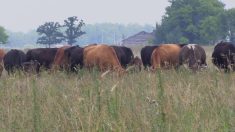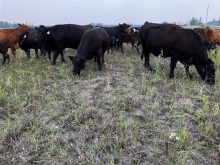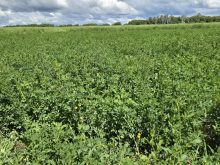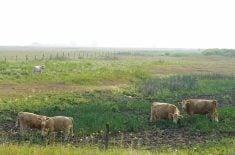Editor’s note: This is part four of a series on the Rural STEP program and the ongoing conundrum of rural depopulation. Read part one, part two and part three.
It’s 1984. The trial of an 18-year-old farm boy from Minnesota makes the pages of the New York Times.
Steven Todd Jenkins is accused of working with his father to lure two local bankers to an empty farmhouse. There, the newspaper reported, father and son allegedly gunned the men down.
Read Also

Journal pulls long-cited glyphosate study for ethics violations
The journal Regulatory Toxicology and Pharmacology has retracted a 2000 Monsanto-linked glyphosate review, drawing new scrutiny as Bayer faces mounting legal pressure.
By the time the younger Jenkins made it to trial, his dad was gone — found dead by an apparent self-inflicted gunshot in the cab of his truck after a cross-country search by authorities.
It was difficult to find 14 jurors without a connection or a “firm opinion” about the accused, the newspaper wrote. Of the rural county’s residents, numbering just over 8,000, many “saw themselves on page 1 of newspapers around the country.”
Jenkins was later convicted.
Why it matters: Programs were introduced in the 1970s to stop the rural-to-urban population drain in Manitoba, but the following decade was riddled with drought and the impacts of a farm crisis.
The deaths occurred on what had once been the Jenkins’ dairy farm. Crushing financial pressures had led to the operation’s collapse and the Buffalo Ridge State Bank, led by the slain Rudy H. Blythe Jr., had foreclosed on the property.
The case touched “on an emotional topic over much of rural America: a clash between financially pressed farmers and their often-resented financiers,” the New York Times added.
Farms in crisis
The 1980s saw a perfect storm of economic catastrophe that battered farms across the U.S. and Canada.
Earlier stories in this series explored the economic and social forces that led to depopulation of Manitoba’s countryside in the decades after the Second World War, as well as the Schreyer government of the early ‘70s and its “Stay Option,” a group of policies and programs meant to stem the tide. One such program, Rural STEP, employed rural youth in the hopes that they would remain rural.
Decades later, those programs appear to have borne little fruit when it comes to youth retention. Some rural areas have seen numerical growth — municipalities grew almost four per cent from 2016 to 2011 alone — but towns and cities have grown faster.
The same window saw cities grow almost six per cent, while growth in villages and towns topped 7.5 per cent. Every census year has reported fewer farms and, as of 2021, Manitoba had less than half the operations it did in 1976.
The impact of those rural support programs may have been different if the following decade hadn’t been so harsh, with many farms struggling to stay afloat.
Debt and income
“Prairie agriculture, in the mid through late 1980s, is going through a crisis that is perhaps worse than the Great Depression,” said a 1989 report prepared for the Economic Council of Canada to dissect the factors behind the crisis. It had a particular emphasis on debt.
During the 1970s, farmers enjoyed a crop price boom and were looking to increase production. Part of that equation was buying more land and, as demand for the suddenly hot commodity of agricultural land rose, so did land prices. Farm debt levels followed.

The bubble burst when grain prices plummeted in the early ‘80s, a decline made worse by agro-economic policy at the time, particularly in the U.S., analysts note. Those low prices set the tone in the market. Grain prices generally stayed low throughout the decade.
According to the same 1989 report, in the 1987-88 crop year, producers could expect an initial payment from the Canadian Wheat Board of $2.60 per bushel of wheat, though producers might receive an unspecified top-up payment later. Production costs were estimated around $5 per bushel, including land costs.
While some of the deficit was made up by government income stabilization payments, farmers struggled to break even on their crops.
Outside of agriculture policy, producers were also taking a beating at the bank.
Central banks raised interest rates in an attempt to cool raging inflation. Interest rates in the early- and mid-‘70s weren’t low by modern standards, with prime rates bouncing between six per cent to over 10 per cent, according to Statistics Canada records.
However, between 1978 and 1979, the prime rate climbed into the double digits, jumping from 9.69 per cent to 12.9, and, with the exception 1987 (when prime rates dipped to 9.52), stayed there throughout the rest of the decade and into 1990.

At its peak in 1981, Canadians were dealing with a prime rate of 19.29 per cent; bad news for any producer trying to expand their land base, invest in new capital or buy new equipment.
For those who already owed money it could be even worse, depending on the terms of their loan. Debt became very expensive and, if a farm had a lot of it, the operation might be doomed.
To compound the matter, the Prairies were in drought between 1987 and 1989.
Human impact
The ‘80s took their toll on the farm community. The 1989 report for the Economic Council of Canada expressed concerns about farmer alcoholism and suicide.
Between 1976 and 1991, Manitoba lost almost 6,400 farms. In comparison, the 10 census years covering the height of the BSE crisis (2001 to 2011), saw a drop of 5,194 farms, 3,260 of which were cattle and ranching operations.
With all the economic forces either still raging or in recent memory, farming wasn’t an appealing career option for youth striking out on their own.
Jeff Elder, who farms near Wawanesa, graduated from high school in 1986. He had worked on the farm as a kid, but his mind had mainly been on his motorbike, his car and hanging out with friends. He was only nominally aware of the tough times and the years when the family ate a lot of hotdogs and bologna and was unable to take a family vacation.
Elder’s parents felt their sons should go to school and get a trade or career, “something that would support us,” he recalled.
That way, he said, “if we did choose to farm, we’d have something to fall back on. I think, you know, there was some question ‘how viable farming is going to be’ at that point,” Elder added.
He got a job with Manitoba Hydro and worked there for 10 years before returning to the family farm.

Curtis McRae, who now farms near St. Andrews, opted to study engineering after high school.
“I think there just wasn’t money in farming at that point in time,” he said.
He was also more interested in furthering his education, he added.
After his academic career wrapped up in 1995, McRae returned to farming, lured by his interest in emerging farm technology like GPS systems. He and some of his friends worked out their own guidance systems before equipment companies made the technology widely available.
The group had no delusions of grandeur. All knew that farming was hard. Les McEwan, who started farming in 1981, said they may not have expected it to stay so hard for so long.
“You thought, ‘it’s going to be like this for a couple years and things are going to get better,’” he said. “Unfortunately, it took a lot longer than that.”
Ed Grenier, who farms between St. Leon and Altamont, recalled making a presentation in university that unpacked the family farm’s budget.
“Times were thin,” he said, adding that the farmer of the time needed exceptional yields and a year free of problems to make money with grain.
However, his family also raised pigs and could use low-priced crop for feed to get some value. The pigs kept the farm afloat when grain prices were low, and vice versa.
McEwan, who also farms near Altamont, said he knew farming finances would be tough, but the rest of the world didn’t have it easy during that period either.
“Interest rates were going to be high regardless of what I got into,” he said. Going into farming might have seemed like a bad choice, but “there was no easy alternatives.”
Farming did give him a good place to raise his family, he figured.
“The prospect of raising kids in the city didn’t really appeal to me.”

Ag students drop
Enrolment data from the late 1970s to early 1990s shows that the number of students in the University of Manitoba’s agriculture programs dropped in correlation with the hardships of the ‘80s, and ripples of that drop lingered into the following decade.
In a 1986 report, the ag faculty divulged a four-year decline in enrolment in the two-year agriculture diploma course. In 1983, there were 159 first-year students. The next year, there were 135. In 1985, only 121 students opted for the program and, by 1986, enrolment was less than 100. Only 89 students were registered that year.
While not the only reason given for the drop, the university report noted the “general farm situation and pessimistic attitude to farming.”
Enrolment oscillated in subsequent years. In 1991, the program welcomed 130 first-year students. But in 1994, another report shows only 126 first-year students, up from 85 the previous year. That document notes “renewed optimism about agricultural career opportunities” and increased government sponsorship of students in the diploma program.
Murky impacts
It’s not clear what effect agricultural pessimism had on rural population size. Between 1976 and 1981, the rural population of Manitoba decreased by 3.7 per cent, a 2006 StatCan report shows.
However, between 1981 and 1986, the rural population went up slightly by 0.2 per cent and between 1986 and 1990, it grew by another 2.9 per cent. Growth rates were significantly lower than the Canadian average in all three time frames.
This series will continue in the Jan. 25 edition of the Co-operator. The final instalment will ask the question, “Is rural depopulation inevitable? And why does it matter?”
















